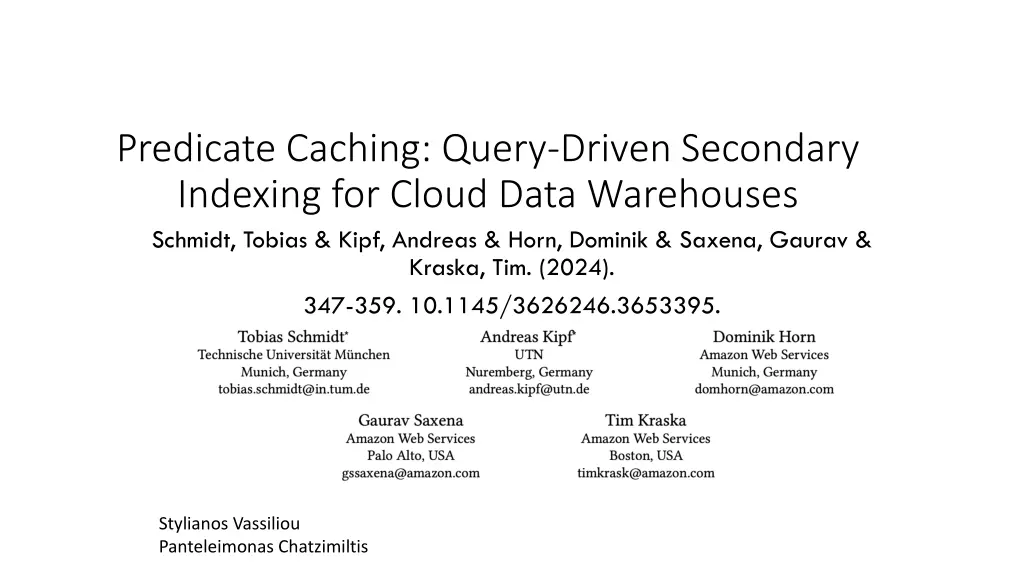
Optimizing Cloud Data Warehouses Through Caching Techniques
Explore the effectiveness of caching techniques in improving performance of cloud data warehouses. Discover how predicate caching, result caching, and materialized views enhance query processing and minimize database overhead. Evaluate the advantages and limitations to implement efficient caching strategies for optimized results.
Download Presentation

Please find below an Image/Link to download the presentation.
The content on the website is provided AS IS for your information and personal use only. It may not be sold, licensed, or shared on other websites without obtaining consent from the author. If you encounter any issues during the download, it is possible that the publisher has removed the file from their server.
You are allowed to download the files provided on this website for personal or commercial use, subject to the condition that they are used lawfully. All files are the property of their respective owners.
The content on the website is provided AS IS for your information and personal use only. It may not be sold, licensed, or shared on other websites without obtaining consent from the author.
E N D
Presentation Transcript
Predicate Caching: Query-Driven Secondary Indexing for Cloud Data Warehouses Predicate Caching Kraska, Tim. (2024). 347-359. 10.1145/3626246.3653395. Schmidt, Tobias & Kipf, Andreas & Horn, Dominik & Saxena, Gaurav & Stylianos Vassiliou Panteleimonas Chatzimiltis
Presentation Outline Caching Background Motivation Predicate Caching Evaluation Conclusion
Presentation Outline Caching Background Motivation Predicate Caching Evaluation Conclusion
Caching Techniques in Cloud Data Warehouses Cloud data warehouses often experience repeating query patterns a key opportunity to improve performance through caching!
Caching Techniques in Cloud Data Warehouses Design Objectives: Low build cost. Low maintenance cost. High reuse potential. Fast lookup performance. Now we will go through some of the caching techniques
Result Caching Stores results of recently executed queries at the cluster node. If the same query is submitted again with the same dataset, the result is returned instantly from the cache.
Result Caching Advantages: Simple No changes needed to database. Low overhead No significant build cost. Performance Cache hits return results within milliseconds instead of minutes! Limitations: Low hit rate Requirement of identical query text and unchanged data High frequency of data-modifying operators (e.g., inserts, copies) Amazon study: 15% of clusters had a hit rate over 50%. >80% hit rate when no updates occur. Hit rate drops sharply as update frequency increases.
Materialized Views Materialized views are for repeating query templates. Amazon Redshift identifies similar queries and reuses precomputed sub-plans instead of executing from scratch. Key advantage over Result Caching: More flexible matching by generalizing query patterns.
Materialized Views Advantages: Matches a broader range of queries than exact-match result caching. Higher flexibility. Limitations: High maintenance overhead: Views must be refreshed on data changes. Insert/delete/update can trigger multiple refreshes. Expected gain must outweigh cost careful tuning required. Bottom Line: MVs offer higher flexibility but come with greater complexity and overhead compared to result caching.
Query-Driven Data Layouts (Qd-tree) Caching technique that reorganizes table data based on repeating filter conditions in queries. Example: If many queries filter on x < 10 and y > 42 , then table is split: One part matches the filters Others are skipped during scans.
Query-Driven Data Layouts (Qd-tree) Advantages: Speeds up queries by skipping unneeded data. Good for cloud systems (reduces data read from storage) Easy to insert/delete data. Limitations: Slow to build. Hard to adapt if the query patterns change. Best for stable, repeating workloads. Bottom Line: Qd-tree improves performance using data layout but it s less flexible than query-level caching.
Presentation Outline Caching Background Motivation Predicate Caching Evaluation Conclusion
Motivation Why a new caching Technique is needed? Goal Result Cache MVs Qd-Tree Online Lightweight On-the-fly Data-independent Design Goals of Predicate Cache: Online: Stays valid with minimal maintenance Lightweight: Avoids time-expensive synchronization On-the-fly: Built during query execution Data-independent: Not invalidated by table updates.
Presentation Outline Caching Background Motivation Predicate Caching Evaluation Conclusion
Predicate Cache Overview How it works: Hash Tables: Stores predicates in memory as hashable strings. Optimization: Cost-based decisions on which predicates to cache based on selectivity and repetitiveness. Tested and seamlessly implementable to Amazon Redshift
Predicate Cache Variants 1. Range Index: Caches row ranges where predicates match. May result in false positives, which are filtered during scan. 2. Bitmap Index: Uses a bitmap to represent blocks of data. Faster to construct but less precise. Which to Use? Range Index: More precise, but uses more space. Bitmap Index: Faster, but less precise.
Query: Count all Region Filters: Region = "EU" Predicate Caching in Action Example Query: Query: Select count(*) from Region_T Filters: Region = EU Row index Region 0 US 1 EU 2 EU 3 US How it works (Caches Filtered Data ): Stores qualifying rows for each predicate: [1-2],[5-7] Next time a similar query is executed, it skips unqualified rows. 4 US 5 EU 6 EU 7 EU 8 US
Predicate Cache on Data Modifications Cache entries remain valid even when data is inserted, deleted, or updated. Inserts: New tuples added at the end. Cached row ranges stay valid. New rows scanned normally and incrementally added to the cache. Deletes: Uses multi-version concurrency control. Deleted rows become invisible, but ranges stay valid. Updates: Old version marked deleted, new version added. Cached predicates remain unaffected. Bottom Line: Predicate caching handles dynamic workloads efficiently without frequent invalidations.
Predicate caching across formats Works with data lakes like Delta Lake and Iceberg. Supports open formats like Parquet, ORC, and CSV Requirements for Use: oStable row identifiers (global row IDs or file offsets). oInfrequent row reordering (to prevent cache invalidation). oDetectable table changes (for correct invalidation). oFormat supports fine-grained reads (to benefit from skipping).
Presentation Outline Caching Background Motivation Predicate Caching Evaluation Conclusion
Memory Consumption Caching offers massive memory footprint reduction over indexes Predicate caching has different sizes depending on implementation Q6 had a single response, so Result Caching is small, but ultimatly it depends on the query Predicate Sorting saves memory but requires full table reorganization
Hit Rate Initial low Hit Rate Cache starts empty Significant increase in hit rate after 15000 queries Reduced number of distinct scans over time.
Query Performance 10% performance improvement Scanned rows 4x less Accessed Blocks reduced by 30% Run time is mostly corelated with block reduction
Presentation Outline Caching Background Motivation Predicate Caching Evaluation Conclusion
Conclusion Caching helps speed up queries in cloud data warehouses. Existing methods (Result Cache, MVs, Qd-Trees) have limits. Predicate Caching is: Fast and simple Stays valid even if data changes Up to 10x faster queries even with frequent updates!
Predicate Caching: Query-Driven Secondary Indexing for Cloud Data Warehouses Predicate Caching Kraska, Tim. (2024). 347-359. 10.1145/3626246.3653395. Schmidt, Tobias & Kipf, Andreas & Horn, Dominik & Saxena, Gaurav & Stylianos Vassiliou Panteleimonas Chatzimiltis






















